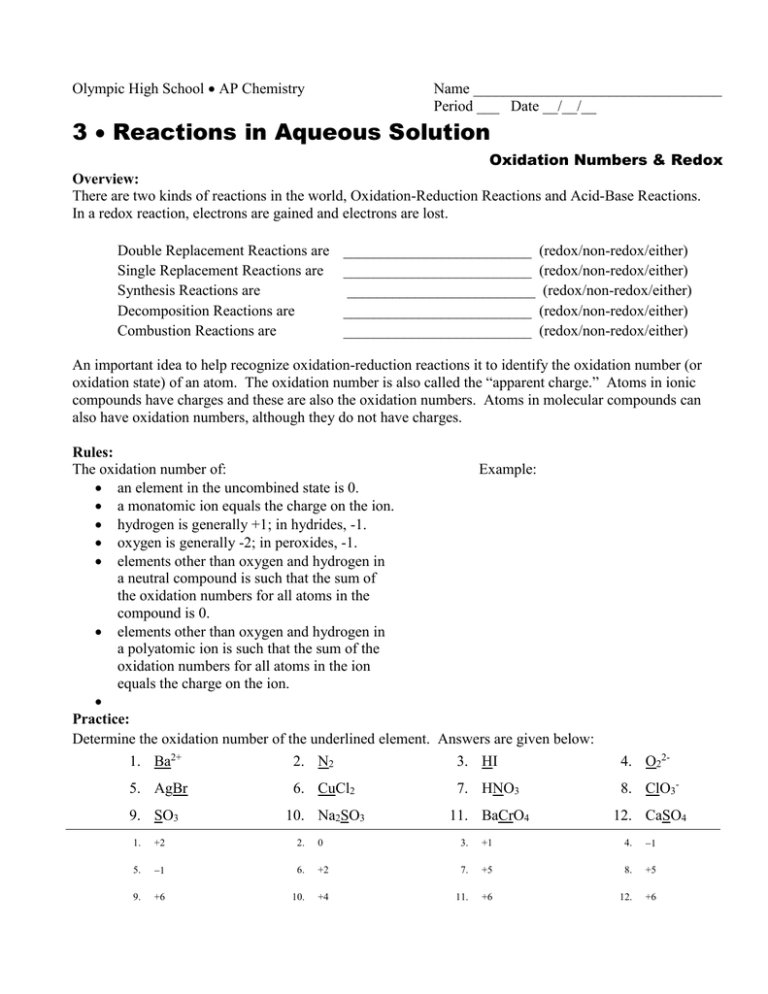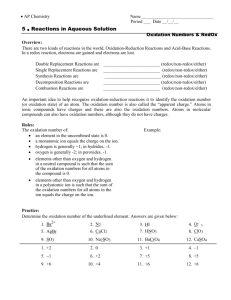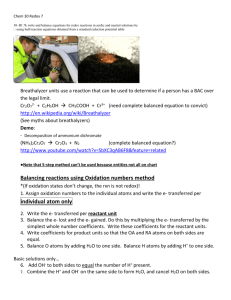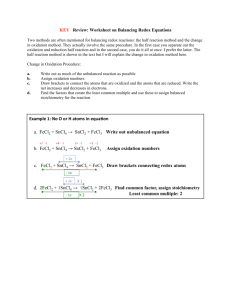3
advertisement

Olympic High School AP Chemistry Name _________________________________ Period ___ Date __/__/__ 3 Reactions in Aqueous Solution Oxidation Numbers & Redox Overview: There are two kinds of reactions in the world, Oxidation-Reduction Reactions and Acid-Base Reactions. In a redox reaction, electrons are gained and electrons are lost. Double Replacement Reactions are Single Replacement Reactions are Synthesis Reactions are Decomposition Reactions are Combustion Reactions are _________________________ (redox/non-redox/either) _________________________ (redox/non-redox/either) _________________________ (redox/non-redox/either) _________________________ (redox/non-redox/either) _________________________ (redox/non-redox/either) An important idea to help recognize oxidation-reduction reactions it to identify the oxidation number (or oxidation state) of an atom. The oxidation number is also called the “apparent charge.” Atoms in ionic compounds have charges and these are also the oxidation numbers. Atoms in molecular compounds can also have oxidation numbers, although they do not have charges. Rules: The oxidation number of: Example: an element in the uncombined state is 0. a monatomic ion equals the charge on the ion. hydrogen is generally +1; in hydrides, -1. oxygen is generally -2; in peroxides, -1. elements other than oxygen and hydrogen in a neutral compound is such that the sum of the oxidation numbers for all atoms in the compound is 0. elements other than oxygen and hydrogen in a polyatomic ion is such that the sum of the oxidation numbers for all atoms in the ion equals the charge on the ion. Practice: Determine the oxidation number of the underlined element. Answers are given below: 1. Ba2+ 2. N2 3. HI 4. O22- 5. AgBr 6. CuCl2 7. HNO3 8. ClO3- 9. SO3 10. Na2SO3 11. BaCrO4 12. CaSO4 1. +2 2. 0 3. +1 4. 1 5. 1 6. +2 7. +5 8. +5 9. +6 10. +4 11. +6 12. +6 Practice Problems from the Textbook 54. Determine the oxidation number of each element in the following ions or compounds: a) BrO3 d) CaH2 2 b) C2O4 e) H4SiO4 c) F2 f) SO42 55. Determine the oxidation number of each element in the following ions or compounds: a) SF6 d) N2O4 b) H2AsO4 e) PCl4+ c) UO2+ f) XeO42 56. Which of the following reactions is (are) oxidation-reduction reactions? Explain your answer briefly. classify the remaining reactions. a) Zn(s) + 2 NO3(aq) + 4 H+(aq) Zn2+(aq) + 2 NO2(g) + 2 H2O(l) b) Zn(OH)2(s) + H2SO4(aq) ZnSO4(aq) + 2 H2O(l) c) Ca(s) + 2 H2O(l) Ca(OH)2(s) + H2(g) 57. Which of the following reactions is (are) oxidation-reduction reactions? Explain your answer briefly. classify the remaining reactions. a) CdCl2(aq) + Na2S(aq) CdS(s) + 2 NaCl(aq) b) 2 Ca(s) + O2(g) 2 CaO(s) c) Ca(OH)2(s) + 2 HCl(aq) CaCl2(aq) + 2 H2O(l) 58. In each of the following reactions, decide which reactant is oxidized and which is reduced. a) 2 Mg(s) + O2(g) 2 MgO(s) b) C2H4(g) + 3 O2(g) 2 CO2(g) + 2 H2O(g) c) Si(s) + 2 Cl2(g) SiCl4(l) 59. In each of the following reactions, decide which reactant is oxidized and which is reduced. a) Ca(s) + 2 HCl(aq) CaCl2(aq) + H2(g) b) Cr2O72(aq) + 3 Sn2+(aq) + 14 H+(aq) 2 Cr3+(aq) + 3 Sn4+(aq) + 7 H2O(l) c) FeS(s) + 3 NO3(aq) + 4 H+(aq) 3 NO(g) + SO42(aq) + Fe3+(aq) + 2 H2O(l)






